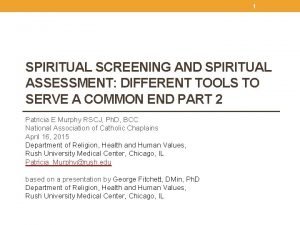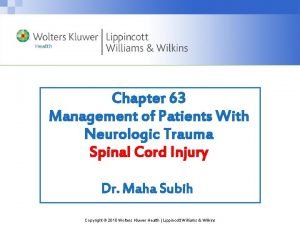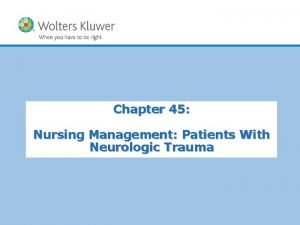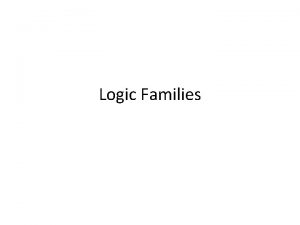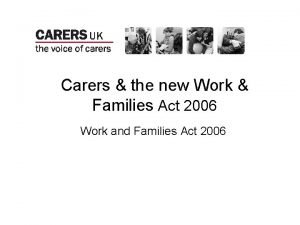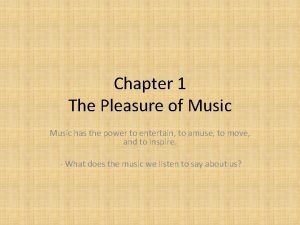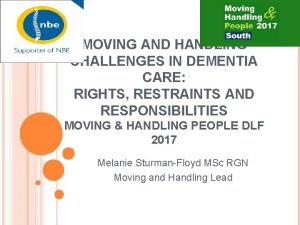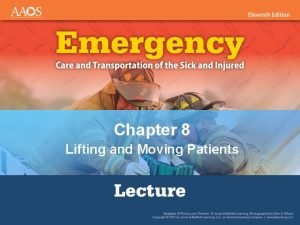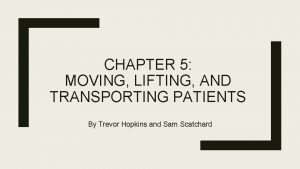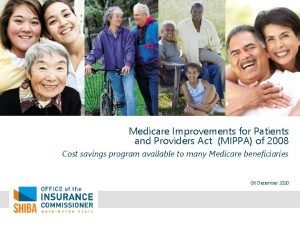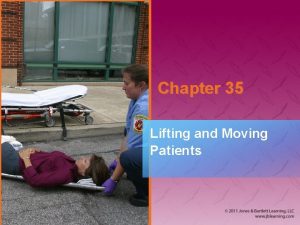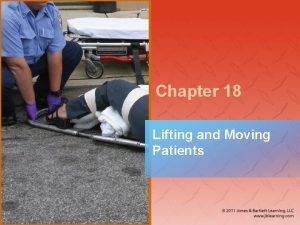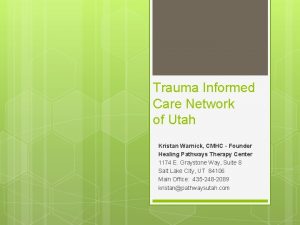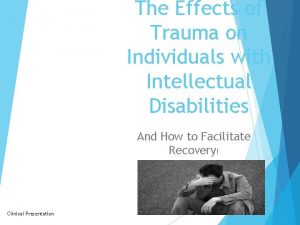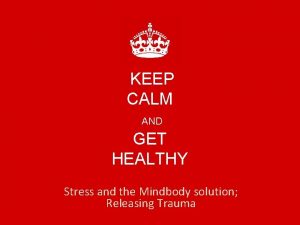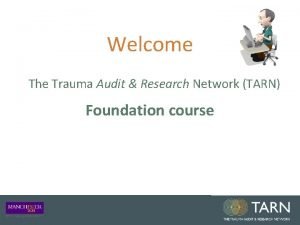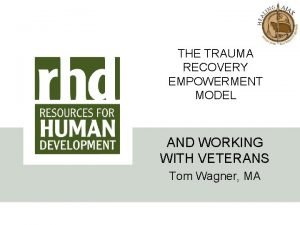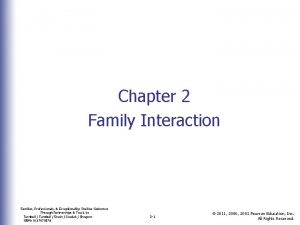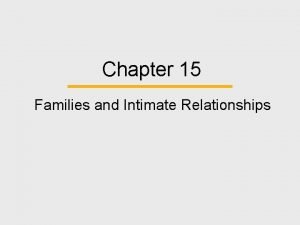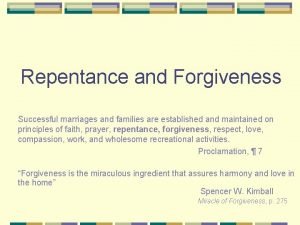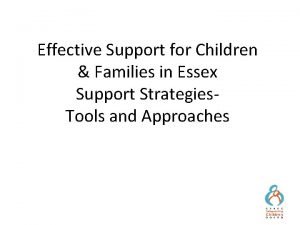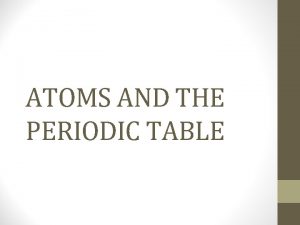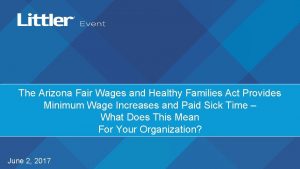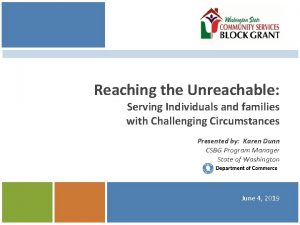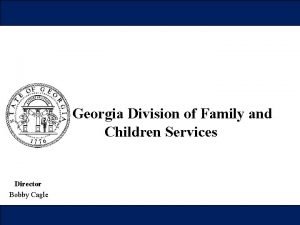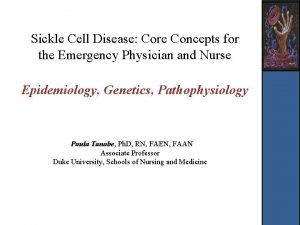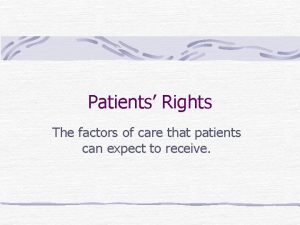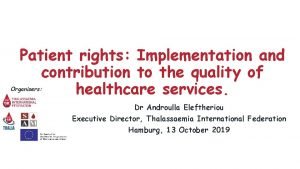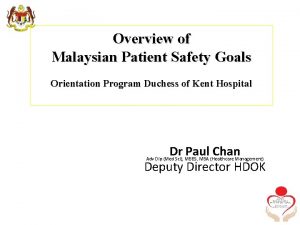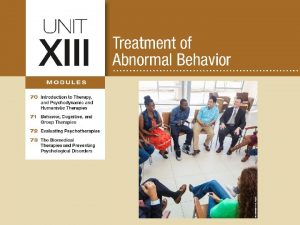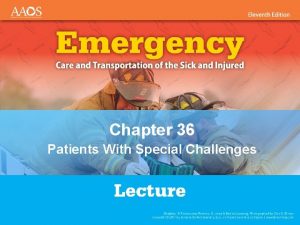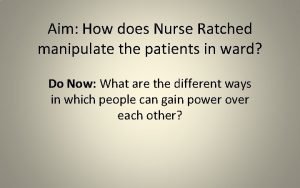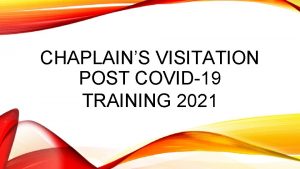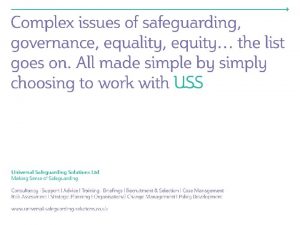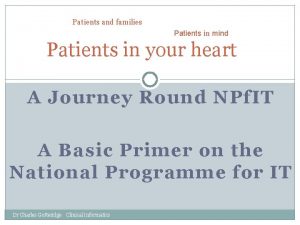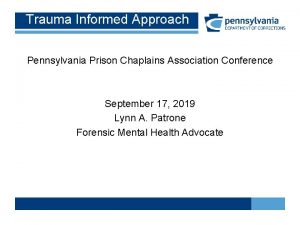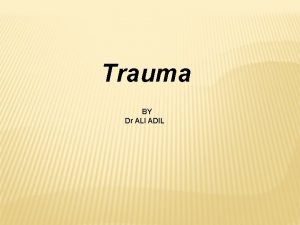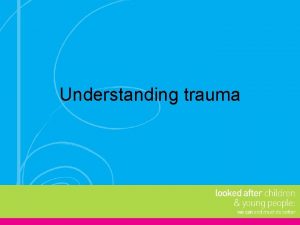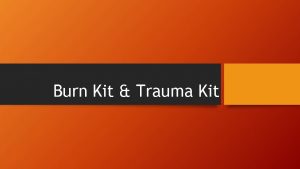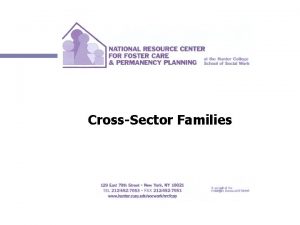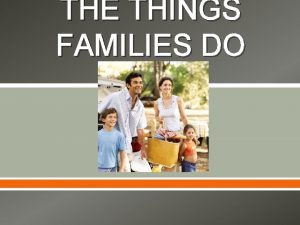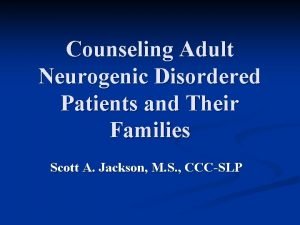Chaplains Work with Trauma Patients and Their Families

























































- Slides: 57

Chaplains’ Work with Trauma Patients and Their Families Chaplain John Ehman 9/21/17

This presentation will focus on working with patients and families at a hospital after a significant blunt or penetrating injury (for example: falls, gunshot or stab wounds, assaults, motor vehicle collisions and pedestrian impacts) or a burn injury. Such trauma patients tend to be initially unavailable to a chaplain, because they are involved in medical assessment/treatment or are unconscious or incoherent. Therefore, chaplains often work first with families who have only just learned of the injury.

TRAUMA • Etymology: from the Greek (τραῦμα / τρῶμα) for wound. • Working Definition #1: A trauma is a serious physical injury or psychological experience that overwhelms our capacity to cope, not only evoking an acute reaction but indelibly affecting our being and sense of well-being. • Working Definition #2: An instantly life-changing event for a patient/family, requiring immediate trust in an unfamiliar medical team in a moment when the world feels particularly uncertain and unsafe. • Practical Emphasis for This Presentation: hours to days after the traumatic event

Psychosocial Hallmarks of Trauma in the Hours/Days after the Event • Acute stress reaction (early on, often more of a practical issue for chaplains working with families than with patients) • Strong tendency to identify cause …and blame • Potential for utterly shattering the sense of one’s world and the struggle for meaning-making in sudden loss • Seeds of Post-Traumatic Stress Disorder (PTSD) and/or Post Traumatic Growth (PTG)

“Cataclysm” By John Ehman

Acute Stress Reaction and Pastoral Response

Acute Stress Reaction “Fight or Flight” Blood (and Sugar) to Muscles and away from Stomach Sudden Change in Heart Rate Hyperventilation and/or Fainting Over-activity / Agitation or Withdrawal /“Daze” Narrowed Attention Intrusive Rumination Impaired Memory and Comprehension Strong, Labile Emotions Heightened Sense of Threat —graphic: Agency for Toxic Substances and Disease Registry, 2005

Paying attention to the physiological dynamics of an acute stress reaction is one way of staying both objective and empathetic toward a patient or family …and to keep from being objectifying, which leaves no room for empathy

What challenge does an acute stress reaction present to a model of patient-led pastoral care? People experiencing acute stress reactions have reduced capacity to take a constructive lead in pastoral interactions. This may require the chaplain to take more of a lead than normal until the reaction subsides, while always working to maximize the opportunity for patient-led pastoral care by seeking to empower the patient or family member. However, while some people in acute stress reactions may be passive and suggestible, others may interpret a chaplain’s initiative as “pushy”; and families may have a mix of these responses, requiring a balancing and modulation of pastoral outreach.

Basic Needs During an Acute Stress Reaction • Normalization (i. e. , manageability) of the extraordinary situation • Control of events; exertion of purpose • Information • Reduced stimuli (--and reduced pressure for cognitive processing) • Space • Sense of connection with others • Hopefulness

Basic Needs During an Acute Stress Reaction • Normalization (i. e. , manageability) of the extraordinary situation • Control of events; exertion of purpose • Information • Reduced stimuli (--and reduced pressure for cognitive processing) • Space • Sense of connection with others • Hopefulness How might chaplains help with these needs?

Basic Needs During an Acute Stress Reaction • Normalization (i. e. , manageability) of the extraordinary situation - Calmly name what is happening; orient people to processes and timing • Control of events; exertion of purpose • Information • Reduced stimuli (--and reduced pressure for cognitive processing) • Space • Sense of connection with others • Hopefulness How might chaplains help with these needs?

Basic Needs During an Acute Stress Reaction • Normalization (i. e. , manageability) of the extraordinary situation - Calmly name what is happening; orient people to processes and timing • Control of events; exertion of purpose - Allow the other to lead as much as feasible; show role of helper/advocate • Information • Reduced stimuli (--and reduced pressure for cognitive processing) • Space • Sense of connection with others • Hopefulness How might chaplains help with these needs?

Basic Needs During an Acute Stress Reaction • Normalization (i. e. , manageability) of the extraordinary situation - Calmly name what is happening; orient people to processes and timing • Control of events; exertion of purpose - Allow the other to lead as much as feasible; show role of helper/advocate • Information - Listen actively; respond to questions; convey information quickly/clearly • Reduced stimuli (--and reduced pressure for cognitive processing) • Space • Sense of connection with others • Hopefulness How might chaplains help with these needs?

Basic Needs During an Acute Stress Reaction • Normalization (i. e. , manageability) of the extraordinary situation - Calmly name what is happening; orient people to processes and timing • Control of events; exertion of purpose - Allow the other to lead as much as feasible; show role of helper/advocate • Information - Listen actively; respond to questions; convey information quickly/clearly • Reduced stimuli (--and reduced pressure for cognitive processing) - Reduce extraneous noise/activity; buffer decision-making pressure • Space • Sense of connection with others • Hopefulness How might chaplains help with these needs?

Basic Needs During an Acute Stress Reaction • Normalization (i. e. , manageability) of the extraordinary situation - Calmly name what is happening; orient people to processes and timing • Control of events; exertion of purpose - Allow the other to lead as much as feasible; show role of helper/advocate • Information - Listen actively; respond to questions; convey information quickly/clearly • Reduced stimuli (--and reduced pressure for cognitive processing) - Reduce extraneous noise/activity; buffer decision-making pressure • Space - Avoid “trapped” space; give “own” space, esp. for emotional expression • Sense of connection with others • Hopefulness How might chaplains help with these needs?

Basic Needs During an Acute Stress Reaction • Normalization (i. e. , manageability) of the extraordinary situation - Calmly name what is happening; orient people to processes and timing • Control of events; exertion of purpose - Allow the other to lead as much as feasible; show role of helper/advocate • Information - Listen actively; respond to questions; convey information quickly/clearly • Reduced stimuli (--and reduced pressure for cognitive processing) - Reduce extraneous noise/activity; buffer decision-making pressure • Space - Avoid “trapped” space; give “own” space, esp. for emotional expression • Sense of connection with others - Use the family’s own support system; facilitate getting people together • Hopefulness How might chaplains help with these needs?

Basic Needs During an Acute Stress Reaction • Normalization (i. e. , manageability) of the extraordinary situation - Calmly name what is happening; orient people to processes and timing • Control of events; exertion of purpose - Allow the other to lead as much as feasible; show role of helper/advocate • Information - Listen actively; respond to questions; convey information quickly/clearly • Reduced stimuli (--and reduced pressure for cognitive processing) - Reduce extraneous noise/activity; buffer decision-making pressure • Space - Avoid “trapped” space; give “own” space, esp. for emotional expression • Sense of connection with others - Use the family’s own support system; facilitate getting people together • Hopefulness - Be attentive to “brittle” hope (i. e. , wishing for highly specific things) How might chaplains help with these needs?

S. O. L. E. R. : A Strategy for Presence Originally proposed by psychologist Gerard Egan as a way to “make sure you are physically present to a client, ” the S. O. L. E. R. strategy has been widely adopted by emergency responders and crisis counselors. S: sit facing the person --at an angle may be preferred O: have an open posture (with no crossed arms or legs) L: slightly lean in toward the person (though not aggressively) E: make eye contact (where this is not culturally contraindicated) R: be relaxed, non-anxious See: Stickley, T. , “From SOLER to SURETY for effective nonverbal communication, ” Nurse Education in Practice 11, no. 6 (Nov 2011): 395 -398; and Egan, G. , The Skilled Helper, 1975.

What are the dynamics around physical touch? In addition to normal cultural and interpersonal dynamics, a chaplain’s touch during an acute stress reaction could potentially play into a person’s heightened sense of threat. In the context of a family system, some people may even see a chaplain’s touch of another family member as threatening to family roles. Chaplains should try to utilize the immediate support resources within a family system as much as possible -- e. g. , family members’ roles for caretaking of others -- and consider taking cues from family leaders regarding physical touch.

Working with/through the family’s own system for order and care: • Identify key family authorities and managers (--including information managers). • Feel free to ask for the help of key family members in caring for particularly needful individuals and in managing the family as a whole. • Family members’ roles tend to be resilient. (Acting in an established family role during a crisis is a way of coping with an acute stress reaction. ) • Imagine the family system’s response as somewhat analogous to an “immune system” response to an injury to the “body” of the family.

How might a religious role of the chaplain play into basic needs of the family/patient during an acute stress reaction situation?

Some Aspects of the Religious Role of a Chaplain Explicit Engagement and Honoring of Patient/Family Spirituality Professional Connection to Community Clergy Religious “Authority” Representing the Presence of God Wisdom/Experience of “Clergy” in Extraordinary Situations Ritual Leadership (especially prayer) Pastoral Ethic of Caring and Trustworthiness

Some Aspects of the Religious Role of a Chaplain Explicit Engagement and Honoring of Patient/Family Spirituality Professional Connection to Community Clergy Religious “Authority” Representing the Presence of God Wisdom/Experience of “Clergy” in Extraordinary Situations Ritual Leadership (especially prayer) Pastoral Ethic of Caring and Trustworthiness …but the religious role may be insignificant or even dysfunctional if people aren’t able or willing to accept it

A Note about Safety-Based Needs • Be prepared for falls and collapses; avoid cluttered spaces • Reduce the presence of sharp, breakable, or throw-able objects • Be attentive to warning signs of medical crises (e. g. , cardiac, diabetic) • Be attentive to effects of alcohol/drugs

A Note about Safety-Based Needs • Be prepared for falls and collapses; avoid cluttered spaces • Reduce the presence of sharp, breakable, or throw-able objects • Be attentive to warning signs of medical crises (e. g. , cardiac, diabetic) • Be attentive to effects of alcohol/drugs • For the chaplain, personally: - prepare for how to avoid trapped space - have a measured plan for response to physical threat or medical crisis - help other responders to gain perspective on what is happening - be prepared for anger, and be mindful to de-escalate tensions

A Note about Safety-Based Needs • Be prepared for falls and collapses; avoid cluttered spaces • Reduce the presence of sharp, breakable, or throw-able objects • Be attentive to warning signs of medical crises (e. g. , cardiac, diabetic) • Be attentive to effects of alcohol/drugs • For the chaplain, personally: - prepare for how to avoid trapped space - have a measured plan for response to physical threat or medical crisis - help other responders to gain perspective on what is happening - be prepared for anger, and be mindful to de-escalate tensions (seek to minimize a need to compromise your non-anxious presence)

How might you – the chaplain – minimize your own acute stress reaction? • Pay attention to cues from your own body, and acknowledge a need to break the stress cycle. • When you feel “out on a limb, ” remember that you are part of a team. • Look for small opportunities to “catch your breath” and refocus on the situation. • Make intentional use of “down time” between events to relax, refocus, and debrief (--you are more susceptible to an acute stress reaction if you are tired, “wired, ” or in need of food/water).

Challenge for the Chaplain During a Trauma Response Keeping Objective Perspective as Part of a Professional Care Team Offering Emotional Engagement as Vital to Pastoral Practice Managing One’s Own Personal Stress Reaction to the Situation

“Light in a Fractured World” By John Ehman

In the Special Case of a Patient’s Death Soon after Hospitalization There is a limited opportunity for the chaplain to make an impact on the family’s subsequent journey of healing, by taking advantage of last interactions with family members.

“Sowing Seeds for Healing” in the Grieving Family • Express sorrow specifically for the loss (as opposed to an open-ended statement of “I’m sorry”). Speak eye-level to eye-level and, unless contraindicated, let the family know that you’ll keep them and their loved one in your thoughts/prayers that night. Look for opportunities to make small gestures of compassion, as families in shock may not remember what has been said as much as what has been done. • Encourage the family to talk about their loss in the days ahead, but acknowledge that everyone in the family will be moving through grief in their own way, and some people outside of the family may have a hard time hearing and understand their traumatic feelings. (This may be a specific message for the family member who appears to be taking the lead in overseeing the family’s needs. ) • Plant the idea of a bereavement support group or formal counseling. State that many people find this helpful. • If practical, walk the family to the door. Let them leave you instead of you leaving them. Be receptive to the family’s hugs.

Strong Tendency to Identify Cause …and Blame

Attribution of Cause/Blame in Trauma • Easy for people to “connect the dots” regarding the trauma, resulting in taking responsibility or attributing responsibility • A meaning-making/coping response that simplifies the sense of overwhelming chaos and pain • Blame may be re-directed when an identified cause is unacceptable (e. g. , self, sacrosanct family member, God) • The Care Team members may be available options for blame unless perceived as the patient’s champions • Caregivers should avoid taking sides in a blame game, and continually emphasize a focus on the care and dignity of the patient

Attributions of Responsibility Research into the blaming of self or others after traumatic events has produced mixed findings but suggests that attributions of responsibility are complex and may potentially affect health outcomes. If attributions of responsibility involve a person’s religious beliefs (e. g. , “God is testing me” or “the devil did this to me”), they play into the particular dynamic of religious coping and may signal spiritual distress.

Shattering the Sense of One’s World

An Overwhelming Sense of Loss In trauma, immediate loss and anticipatory loss (usually rooted in past loss) flood together and can overwhelm a sense of perspective. One’s entire world may feel utterly shattered, in the present moment, which can seem unmoored from what has given life order and meaning. In such a time, how might we regain the moorings of order and meaning for our lives? How might we find our way to feeling more than just loss and chaos?

Maintaining / Regaining a Sense of Meaning after Trauma A classic model of coping after trauma turns on the alignment or realignment of one’s interpretation of a traumatic event with one’s larger worldview. Some research suggests that religious beliefs, as a part of a person’s religious life, can be an especially strong factor in maintaining or regaining congruence between an understanding of a trauma and a sense of global meaning.

Basic Model of Coping with Traumatic Stressors Worldview Assumptions / Beliefs

Basic Model of Coping with Traumatic Stressors Worldview Assumptions / Beliefs Traumatic Stressor

Basic Model of Coping with Traumatic Stressors Worldview Assumptions / Beliefs Traumatic Stressor Appraised Meaning of the Stressor

Basic Model of Coping with Traumatic Stressors Worldview Assumptions / Beliefs Discrepancy? Traumatic Stressor Appraised Meaning of the Stressor

Basic Model of Coping with Traumatic Stressors Coping may involve a change in Worldview Assumptions /Beliefs and/or reappraisal of the Stressor Worldview Assumptions / Beliefs Discrepancy? Traumatic Stressor Appraised Meaning of the Stressor

Basic Model of Coping with Traumatic Stressors Coping may involve a change in Worldview Assumptions /Beliefs and/or reappraisal of the Stressor Worldview Assumptions / Beliefs Discrepancy? Traumatic Stressor Appraised Meaning of the Stressor

An Augmented Model of Coping with Traumatic Stressors Zukerman, G. and Korn, L. , “Post-Traumatic Stress and World Assumptions: The Effects of Religious Coping, ” Journal of Religion and Health 53, no. 6 (Dec 2014): 1676 -1690 Coping may involve a change in Worldview Assumptions /Beliefs and/or reappraisal of the Stressor Worldview Assumptions / Beliefs Religious Beliefs Traumatic Stressor Appraised Meaning of the Stressor Discrepancy?

The Seeds of Post-Traumatic Stress Disorder and Post-Traumatic Growth for the Patient

Common After-Effects of Trauma • Intrusive thoughts, including flashbacks to the traumatic event • Desire to avoid people or conversations (esp. re: the event) • Emotionally numb or emotionally overwhelmed at various times • Negative mood; negative feelings toward self and/or others • On edge; sensitive to little things as irritating or threatening • Trouble concentrating of sleeping (including nightmares)

Responding to Patients to Encourage Psychosocial Health 1) Listen attentively, actively, responsively. 2) Acknowledge – generally, without taking a position on a patient’s questions/conclusions – statements of meaning-making and relationship. 3) Affirm how a traumatic event is an emotional event, which can hit us in waves of feeling overwhelmed. 4) Encourage the patient not to be alone in thinking about what’s happened but rather to think things through with trained counselors, support groups, or at least trusted friends (–though not all friends will know how to be helpful).

Post-Traumatic Growth (PTG) The idea of PTG is that many people can recognize experiences of personal “growth” emerging from a traumatic incident, even while suffering such negative effects as Post-Traumatic Stress Disorder. Research on PTG has focused on themes of: • a greater appreciation for life in general • a more enriching sense of relationships • an awareness of one’s own strengths • the perception of new possibilities • a deepening sense of spirituality

Post-Traumatic Growth (PTG) The idea of PTG is that many people can recognize experiences of personal “growth” emerging from a traumatic incident, even while suffering such negative effects as Post-Traumatic Stress Disorder. Research on PTG has focused on themes of: • a greater appreciation for life in general • a more enriching sense of relationships • an awareness of one’s own strengths • the perception of new possibilities • a deepening sense of spirituality Chaplains can acknowledge “growth” …but never at the expense of acknowledging the deep injury of trauma.

“Horizon” By John Ehman

Postscriptum Chaplains’ Experience and Self-Care: Contending with Secondary Traumatic Stress (STS) and Vicarious Traumatization

Chaplains and Secondary Traumatic Stress / Vicarious Traumatization When we engage sufferers of trauma at an emotional and empathic level, we can become susceptible to the effects of traumatic experience. This often occurs after repeated exposures over time, but the process can be exacerbated by our particular sensitivities from our own stories.

Chaplains and Secondary Traumatic Stress / Vicarious Traumatization When we engage sufferers of trauma at an emotional and empathic level, we can become susceptible to the effects of traumatic experience. This often occurs after repeated exposures over time, but the process can be exacerbated by our particular sensitivities from our own stories. Warning signs include: • avoidance of topics or situations with patients • difficulty empathizing or feeling compassion • trouble attending to proper boundaries • lack of interest in work / “going through the motions” • sense of cynicism or disillusionment • PTSD-like symptoms (for example: flashbacks)

Professional caregivers’ responsibility to stay whole and able for those who look to us for help. • Self-care as a personal discipline (including attention to support from others) • Intentional use of professional experiences to advance one’s capacity for caregiving • Idea of vicarious resilience

john. ehman@uphs. upenn. edu

 7x7 model for spiritual assessment
7x7 model for spiritual assessment Lippincott williams
Lippincott williams Management of patients with neurologic trauma
Management of patients with neurologic trauma Little families
Little families Characteristics of logic families
Characteristics of logic families Work and families act 2006
Work and families act 2006 Chapter 4 work and energy section 1 work and machines
Chapter 4 work and energy section 1 work and machines Compare and contrast the bach and marsalis families
Compare and contrast the bach and marsalis families Compare and contrast the bach and marsalis families
Compare and contrast the bach and marsalis families Family of orientation
Family of orientation Marriages and families changes choices and constraints
Marriages and families changes choices and constraints Emergency patient move
Emergency patient move Wendylett sheets 1 carer
Wendylett sheets 1 carer When performing the rapid extrication technique
When performing the rapid extrication technique Semi fowler's position
Semi fowler's position 12 patient rights
12 patient rights Define inadequate
Define inadequate Medicare improvements for patients and providers act
Medicare improvements for patients and providers act Whenever you grasp a stretcher or backboard
Whenever you grasp a stretcher or backboard Ems lifting techniques
Ems lifting techniques From ancient grudge break to new mutiny translation
From ancient grudge break to new mutiny translation Trauma awareness and treatment center utah
Trauma awareness and treatment center utah Triune brain theory and trauma
Triune brain theory and trauma Limbic system and trauma
Limbic system and trauma Trauma audit and research network
Trauma audit and research network Trauma recovery and empowerment model
Trauma recovery and empowerment model Uccs health center
Uccs health center Hard work or smart work
Hard work or smart work Work energy theorem
Work energy theorem Families professionals and exceptionality
Families professionals and exceptionality Family life today
Family life today Who studied the juke family tree
Who studied the juke family tree Why are the von gradwitz and znaeym families fighting?
Why are the von gradwitz and znaeym families fighting? Successful marriages and families
Successful marriages and families Effective support for children and families in essex
Effective support for children and families in essex Nucleus in periodic table
Nucleus in periodic table Chapter 10 western musical instruments
Chapter 10 western musical instruments Prop 206 arizona pros and cons
Prop 206 arizona pros and cons Serving individuals and families
Serving individuals and families Serving individuals and families
Serving individuals and families The needs of families and suitability for the local
The needs of families and suitability for the local Working with culturally and linguistically diverse families
Working with culturally and linguistically diverse families Georgia department of children and families
Georgia department of children and families Individuals and families diverse perspectives
Individuals and families diverse perspectives Families professionals and exceptionality
Families professionals and exceptionality Life expectancy of sickle cell patients
Life expectancy of sickle cell patients Bed making assignment
Bed making assignment Perimylolysis
Perimylolysis Factors of care patients can expect to receive
Factors of care patients can expect to receive Patients rights charter
Patients rights charter Patient safety goals malaysia
Patient safety goals malaysia Nursing management of patient with cataract
Nursing management of patient with cataract Ncp of ocd
Ncp of ocd Nurse leader rounding
Nurse leader rounding Dr carlson advises his depressed patients
Dr carlson advises his depressed patients Patients with special challenges
Patients with special challenges How does nurse ratched manipulate the patients
How does nurse ratched manipulate the patients Types of admission hospital
Types of admission hospital
